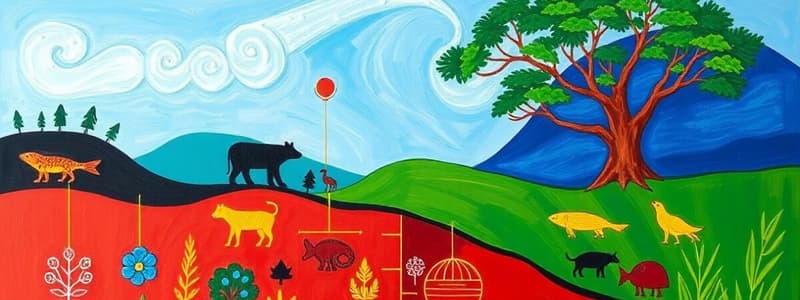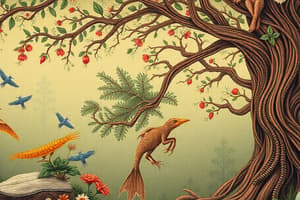Podcast
Questions and Answers
What is an ecosystem primarily defined by?
What is an ecosystem primarily defined by?
- Interactions between organisms and their environment (correct)
- The physical geography of a location
- The variety of plant species
- The number of consumers in an area
What do abiotic components of an ecosystem include?
What do abiotic components of an ecosystem include?
- Microorganisms that decompose organic matter
- Climatic conditions and energy sources (correct)
- Animals that live in the environment
- Plants that produce energy through photosynthesis
Which of the following correctly describes the flow of energy in a food chain?
Which of the following correctly describes the flow of energy in a food chain?
- From producers to consumers to apex predators (correct)
- From decomposers to consumers and then producers
- From consumers to decomposers only
- From apex predators to producers
What role does a decomposer play in an ecosystem?
What role does a decomposer play in an ecosystem?
Which statement is true about the structure of an ecosystem?
Which statement is true about the structure of an ecosystem?
What describes the term 'niche' in ecology?
What describes the term 'niche' in ecology?
How do producers contribute to the food chain?
How do producers contribute to the food chain?
Which sequence accurately represents a typical food chain?
Which sequence accurately represents a typical food chain?
What is the role of sunlight in an ecosystem?
What is the role of sunlight in an ecosystem?
What happens to energy as it moves through the levels of a food chain?
What happens to energy as it moves through the levels of a food chain?
Flashcards
Ecosystem
Ecosystem
A unit in ecology where living things interact with each other and their environment.
Structure of an Ecosystem
Structure of an Ecosystem
How biotic (living) and abiotic (non-living) things are organized in an ecosystem, including energy distribution and climate.
Biotic Components
Biotic Components
The living parts of an ecosystem, including producers, consumers, and decomposers.
Abiotic Components
Abiotic Components
Signup and view all the flashcards
Food Chain
Food Chain
Signup and view all the flashcards
Producer
Producer
Signup and view all the flashcards
Consumer
Consumer
Signup and view all the flashcards
Decomposer
Decomposer
Signup and view all the flashcards
Niche
Niche
Signup and view all the flashcards
Primary Consumer
Primary Consumer
Signup and view all the flashcards
Study Notes
Ecosystem
- An ecosystem is a structural and functional unit in ecology.
- Living organisms interact with each other and their environment within an ecosystem.
- An ecosystem is a chain of interactions between organisms and their environment.
Ecosystem Structure
- Ecosystems are characterized by both biotic (living) and abiotic (non-living) components.
- Energy distribution is part of the ecosystem structure.
- Climatic conditions within a specific environment also form part of the ecosystem.
Food Chain
- Light energy is converted to chemical energy in a biological process and passed through successive levels.
- The flow of energy from a producer (e.g., grass) through consumers (e.g., grasshopper, mice, snake) to an apex predator (e.g., eagle) or detritivore forms a food chain.
- Example of a food chain: Grass → Grasshopper → Mouse → Snake → Eagle
Components of an Ecosystem
- Biotic components: Living organisms (e.g., plants, animals, microorganisms).
- Producers: Organisms that make their own food (e.g., plants).
- Consumers: Organisms that eat other organisms (e.g., herbivores, carnivores).
- Primary consumers: Organisms that eat producers (e.g., herbivores that eat plants).
- Secondary consumers: Organisms that eat primary consumers (e.g., carnivores that eat herbivores).
- Tertiary consumers: Organisms that eat secondary consumers (e.g., carnivores that eat other carnivores).
- Decomposers: Organisms that break down dead organisms and return nutrients to the ecosystem (e.g., fungi, bacteria).
- Abiotic components: Non-living factors (e.g., water, soil, sunlight).
Niche
- In ecology, the term "niche" describes the role an organism plays within its community.
Studying That Suits You
Use AI to generate personalized quizzes and flashcards to suit your learning preferences.
Related Documents
Description
Explore the fundamental concepts of ecosystems and food chains through this engaging quiz. Understand the interactions between biotic and abiotic components, along with energy flow in ecological systems. Test your knowledge about the structure and dynamics of ecosystems.




